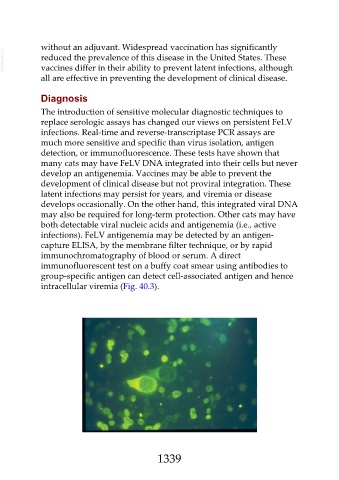Page 1339 - Veterinary Immunology, 10th Edition
P. 1339
without an adjuvant. Widespread vaccination has significantly
VetBooks.ir reduced the prevalence of this disease in the United States. These
vaccines differ in their ability to prevent latent infections, although
all are effective in preventing the development of clinical disease.
Diagnosis
The introduction of sensitive molecular diagnostic techniques to
replace serologic assays has changed our views on persistent FeLV
infections. Real-time and reverse-transcriptase PCR assays are
much more sensitive and specific than virus isolation, antigen
detection, or immunofluorescence. These tests have shown that
many cats may have FeLV DNA integrated into their cells but never
develop an antigenemia. Vaccines may be able to prevent the
development of clinical disease but not proviral integration. These
latent infections may persist for years, and viremia or disease
develops occasionally. On the other hand, this integrated viral DNA
may also be required for long-term protection. Other cats may have
both detectable viral nucleic acids and antigenemia (i.e., active
infections). FeLV antigenemia may be detected by an antigen-
capture ELISA, by the membrane filter technique, or by rapid
immunochromatography of blood or serum. A direct
immunofluorescent test on a buffy coat smear using antibodies to
group-specific antigen can detect cell-associated antigen and hence
intracellular viremia (Fig. 40.3).
1339

